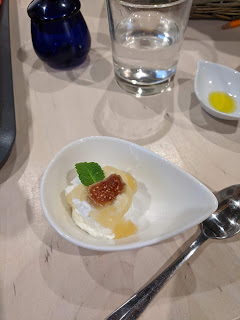The museum is pretty close to Pula's famous Roman amphitheatre, and clearly signposted. You can opt for a visit only, or add a regular or "gold" tasting experience at the end (which includes a "surprise" dessert). We chose gold, since it was our only stop for the day and we'd waited a year for this excitement.
The museum isn't large - really just an exhibition hall - but it's packed with information on the history and production of olive oil in the region over the past two thousand years. As far as I could make out, the audio guide isn't much more than the info on the boards, but I soon gave up on it, as usual - am I the only one who can't cope with simultaneously looking at and listening to information? However, the child's one kept the four year-old happy and practising his numbers.
So, onto interesting facts. When the Romans expanded down into the Istrian region, they quickly established olive growing. Did you know that they graded their olive oil? Or that for centuries, oil was separated by the process of pouring hot water on it, so that it would rise to the top and could be skimmed off? The best was from young, green olives and the worst, from damaged fruit, was used for lamps and given to slaves. Although villas were abandoned as the empire collapsed, olive oil kept its value as a local product, as witnessed by the legislation - and legal disputes - that abounded in the middle ages over growing rights. During the Venetian period, the new empire tried to restrict the passage of olive oil, to ensure it kept its share of the profit, so a smuggling route grew up via the Trieste region (which I presume took in Koper, where we live).
Istria is often overlooked as an olive-growing region, but it has been gaining a reputation for its high quality, often organic, oils. This is about the farthest north you can grow olives and it's claimed that makes them better. I'm not an olive expert, but chemical analysis of the health-giving properties (polyphenols) of olives just puts the Istrian varieties on top, with Spain a close second. Sorry, Greece.
After we perused the museum, our host took us into the tasting room. The first round (which is what you get with a basic tasting) consisted of two real extra virgin olive oils, plus a generic plastic bottle from the supermarket. We had a helpful vocabulary list up on a projector, though I don't know how I was supposed to identify artichoke or olive leaves. The first things we noticed about the single blend was that it smelled of grass - apparently that's a good thing. The surprise was swallowing it and getting a burning sensation in the back of the throat - also apparently a good thing.
Then on to the supermarket oil, plus the (non) virgin truth - most of the cheap extra virgin olive oil you buy is in fact just a small amount of the real thing, cut with the chemically-refined worst grade, which is called lampante, from the reference to the oil the Romans deemed only good enough for lamps (and slaves). I'd like to pretend I was instinctively gourmet, but I'm going to confess that if I hadn't just been educated about it, I might have thought the second one tasted like olive oil is 'supposed' to and that the first had something wrong with it. We also (okay, me) felt sort of guilty that only the day before, Ted had come home triumphant from a supermarket trip in Italy with a bargain five-litre plastic bottle of 'extra virgin' olive oil. Well, it's good or cooking.
You'll see from the photos that we got our oil in dishes, but for official tastings they come in little blue glass jars (there's one in front of the tray) so that the colour is masked.
Proceedings were briefly interrupted by Alcuin deciding to get down from the bar stool by just hopping off, and promptly hitting the ground. Luckily not hard enough to produce screams.
For the next round, our host introduced us to a selection of five oils, ranging from "grassy" to "bitter", and including blends and a local oil. Honestly, I could not pick a best. I think my olive-oil tasting muscles need honing.
Rounding it off was a special dessert, which consisted of the local fresh cheese (similar to ricotta), topped with creamed flower honey and a slice of dried fig. And the finishing touch was a few drops of olive oil of our choice. Pretty good.
We left with two bottles of good olive oil (plus a face cream), better educated on all the questions I have never asked on olive oil, and with a couple of new places on our to-visit list after reading all the info about the region - plus the sun had come out, so I'd call that successful.
 |
| Sculpture by Josip Diminić |





No comments:
Post a Comment